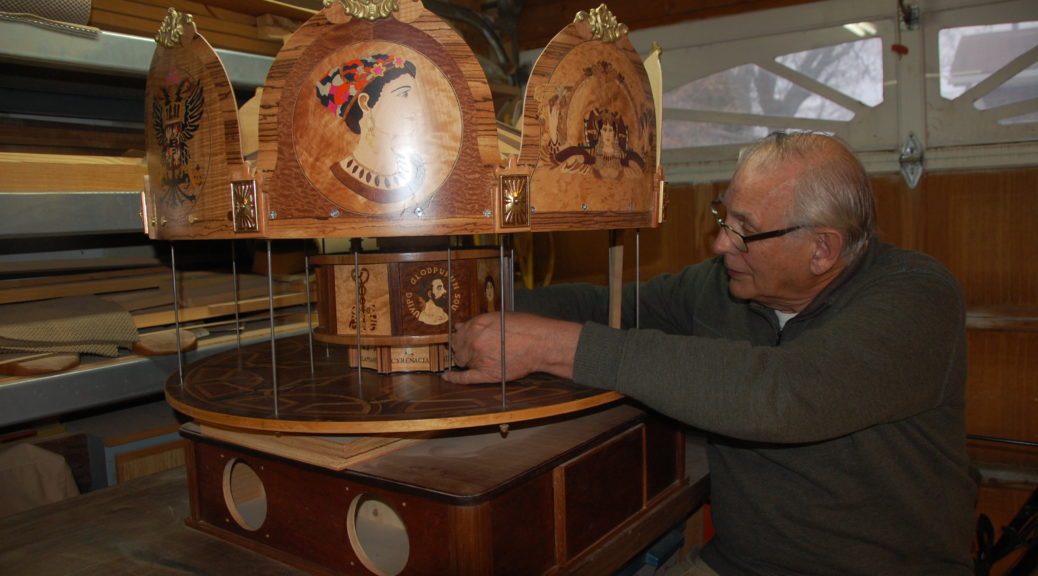
(To view our January/February 2019 issue of ClubWEST online, click here.)
60 Years in the making

By Joanne McDonald
Scratch the veneer from John Sedgwick and you’ll find a man who loves wood.
His Grimsby home is a showcase of award-winning marquetry created on furniture that he has made, a testament to both the ancient art of exquisitely worked veneers and his skill and passion for the work.
His woodworking shop out back is a place of mindfulness where the world disappears in the focus of the wood. Lines of clamps hang from the shop walls with a precision that speaks to his profession as a mechanical engineer.
It appears there are clamps enough to lock down a fort, yet says Sedgwick, gleefully sharing the woodworkers’ universal lament, you can never have too many clamps.
“He who dies with the most clamps wins.”
In the corner sits the piece de resistance – a carousel – 20 years of intricate marquetry in the making and now just eight months short of completion. It is a masterpiece.
Constructed on a mechanically engineered rotating circular platform and expertly overlaid with artful figures and patterns made of gorgeous wood veneers, the carousel now awaits Sedgwick’s eight hand carved Roman soldiers driving horse-drawn chariots to complete the labour of love.
Researched and themed around the ancient Romans, Sedgwick started carving the horses and making the chariots two years ago. He is now working on the tack to drive the teams.
Marquetry is an intricate and labour-intensive technique where different natural colours of wood veneers are carefully cut to fit precisely together, creating a spectacular design in a single sheet or picture.
“Think of paint by numbers with no numbers and no paint, just naturally coloured wood fitted together like a jigsaw puzzle to create a design or pattern,” he says.
Sedgwick is a fine gentleman.
He speaks with the authority of decades dedicated to the art and his enthusiasm retains the delight of the youngster who received his first hobby veneer kit, a Christmas gift from his father when he was 12 years old.
He was born in England, the Village of Kent where everybody knew everybody and “everybody had a hobby that didn’t plug in.”
His father, Harold had the foresight to introduce his son to the fine art, but could hardly have known the enduring joy it would bring.
There was a company in the UK that sold veneers to the
furniture industry. Large sheets were custom supplied and the discarded bits would end up in a dumpster.
An industrious employee saw an opportunity to use the leftover pieces and he developed a kit with all the ingredients to complete a small craft project.
One of the popular hobbies at the time was paint by number kits.
The employee took the paint by number pattern and thought, “what if I cut the veneers and put numbers on them.”
He took small pieces of veneer, stamped numbers according the paint by numbers pattern and packaged them with a scalpel, a bit of sandpaper, and a few basic instructions to make the kits that are still sold to this day.
“The concept of the kit was to show that you can paint any design and any pattern with wood.”
By the age of 16, Sedgwick was fascinated by the process. He would ‘dumpster dive’ behind cabinet shops to glean small pieces of discarded veneer.
He studied and learned and began making his own
patterns.
The focus on marquetry would go into hiatus for the next few years as Sedgwick, at the age of 18, went into the British Army and served for two years before emigrating to Canada.
He married his wife Maria and together they raised a family while Sedgwick worked on building his own manufacturing company designing automated equipment.
Eventually he found a few extra hours and returning to the fine art in 1982 he turned his focus to finding others who shared his passion. “I thought there must be more people
doing this.”
There was a founding society in the UK and France and as it was the days before the internet, he wrote to England and asked if there were any members in Canada and the US.
He received the names of eight people attached to the British society.
They lived far and wide from Kingston and Niagara through to Detroit and the US. He wrote each one a letter.
Four were actively doing marquetry, two were older cabinet makers by then in their late 70s and two were hobbyists. They formed the Marquetry Society of Canada in 1983.
“I had never met anyone elsr and wanted to see what others were doing,” Sedgwick said.
He started going to wood shows and meeting people with the shared passion and found the woodworkers’ mecca at Lee Valley Tools where he regularly teaches seminars at locations across the Greater Toronto Area (GTA.)
Students spend a day creating their own projects and learning techniques, some of which come from practices used by the Egyptians more than 3,000 years ago.
Much of Sedgwick’s work has involved repairs of marquetry, including music boxes dating from the 1880s.
Through the process and by necessity he has also honed skills in furniture making, furniture repair, wood carving and turning. And each time he moves on to a new project, of course, he needs more tools – a need to which every woodworker will attest.
His work has earned best of show and best of class awards at juried competitions in Canada, the United States and the U.K.
He has contributed to two books and written many articles. His work has graced the covers of two Lee Valley cataloguemagazines and a catalogue. But always, Sedgwick says modestly, just when you think you’re great, you’re only good.
He finds others, highly skilled, who share his passion and he continues to learn.
Closer to home, Sedgwick was invited last month to exhibit a collection of his work at the Christmas meeting of the Grimsby Probus Club, a sagacious social group by definition, that meets strictly to enjoy the camaraderie of networking with old friends who share decades of professional and life experiences.
For more information about marquetry and photos of Sedgwick’s work visit:
http://www.marquetry-inlayrestorations.com/




